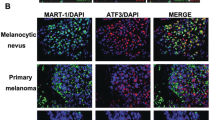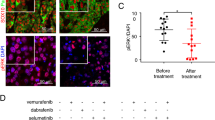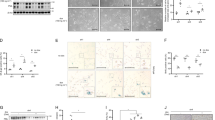Abstract
The melanoma differentiation-associated gene-7 (mda-7) is a known mediator of apoptosis in cancer cells but not in normal cells. We hypothesized that MDA-7 interferes with the prosurvival signaling pathways that are commonly altered in cancer cells to induce growth arrest and apoptosis. We also identified the cell signaling pathways that are antagonized by MDA-7 leading to apoptosis. Using an adenoviral expression system, mda-7 was introduced into the breast cancer cell lines SKBr3, MCF-7 and MDA-MB-468, each with a different estrogen receptor (ER) and HER-2 receptor status. Downstream targets of MDA-7 were assessed by reverse phase protein array analysis, western blot analysis and immunofluorescence confocal microscopy. Our results show that MDA-7-induced apoptosis was mediated by caspases in all cell lines tested. However, MDA-7 modulates additional pathways in SKBr3 (HER-2 positive) and MCF-7 (ER positive) cells including downregulation of AKT-GSK3β and upregulation of cyclin-dependent kinase inhibitors in the nucleus. This leads to cell cycle arrest in addition to apoptosis. In conclusion, MDA-7 abrogates tumor-promoting pathways including the activation of caspase-dependent signaling pathways ultimately leading to apoptosis. In addition, depending on the phenotype of the breast cancer cell, MDA-7 modulates cell cycle regulating pathways to mediate cell cycle arrest.
This is a preview of subscription content, access via your institution
Access options
Subscribe to this journal
Receive 12 print issues and online access
$259.00 per year
only $21.58 per issue
Buy this article
- Purchase on Springer Link
- Instant access to full article PDF
Prices may be subject to local taxes which are calculated during checkout






Similar content being viewed by others
References
American Cancer Society: Breast Cancer Facts & Figures 2009–2010 American Cancer Society Inc.: Atlanta, 2009.
Chada S, Ramesh R, Mhashilkar AM . Cytokine- and chemokine-based gene therapy for cancer. Curr Opin Mol Ther 2003; 5: 463–474.
Gopalan B, Litvak A, Sharma S, Mhashilkar AM, Chada S, Ramesh R . Activation of the Fas-FasL signaling pathway by MDA-7/IL-24 kills human ovarian cancer cells. Cancer Res 2005; 65: 3017–3024.
Mhashilkar AM, Schrock RD, Hindi M, Liao J, Sieger K, Kourouma F et al. Melanoma differentiation associated gene-7 (mda-7): a novel anti-tumor gene for cancer gene therapy. Mol Med 2001; 7: 271–282.
Saeki T, Mhashilkar A, Chada S, Branch C, Roth JA, Ramesh R . Tumor-suppressive effects by adenovirus-mediated mda-7 gene transfer in non-small cell lung cancer cell in vitro. Gene Ther 2000; 7: 2051–2057.
Chada S, Mhashilkar AM, Liu Y, Nishikawa T, Bocangel D, Zheng M et al. mda-7 gene transfer sensitizes breast carcinoma cells to chemotherapy, biologic therapies and radiotherapy: correlation with expression of bcl-2 family members. Cancer Gene Ther 2006; 13: 490–502.
Kawabe S, Nishikawa T, Munshi A, Roth JA, Chada S, Meyn RE . Adenovirus-mediated mda-7 gene expression radiosensitizes non-small cell lung cancer cells via TP53-independent mechanisms. Mol Ther 2002; 6: 637–644.
Sherr CJ, Roberts JM . Inhibitors of mammalian G1 cyclin-dependent kinases. Genes Dev 1995; 9: 1149–1163.
Tibes R, Qiu Y, Lu Y, Hennessy B, Andreeff M, Mills GB et al. Reverse phase protein array: validation of a novel proteomic technology and utility for analysis of primary leukemia specimens and hematopoietic stem cells. Mol Cancer Ther 2006; 5: 2512–2521.
Zhou BP, Liao Y, Xia W, Spohn B, Lee MH, Hung MC . Cytoplasmic localization of p21Cip1/WAF1 by Akt-induced phosphorylation in HER-2/neu-overexpressing cells. Nat Cell Biol 2001; 3: 245–252.
Liang J, Zubovitz J, Petrocelli T, Kotchetkov R, Connor MK, Han K et al. PKB/Akt phosphorylates p27, impairs nuclear import of p27 and opposes p27-mediated G1 arrest. Nat Med 2002; 8: 1153–1160.
Liang J, Slingerland JM . Multiple roles of the PI3K/PKB (Akt) pathway in cell cycle progression. Cell Cycle 2003; 2: 339–345.
Chada S, Mhashilkar AM, Ramesh R, Mumm JB, Sutton RB, Bocangel D et al. Bystander activity of Ad-mda7: human MDA-7 protein kills melanoma cells via an IL-20 receptor-dependent but STAT3-independent mechanism. Mol Ther 2004; 10: 1085–1095.
Sarkar D, Lebedeva IV, Gupta P, Emdad L, Sauane M, Dent P et al. Melanoma differentiation associated gene-7 (mda-7)/IL-24: a ‘magic bullet’ for cancer therapy? Expert Opin Biol Ther 2007; 7: 577–586.
Zhou BP, Hung MC . Novel targets of Akt, p21(Cipl/WAF1), and MDM2. Semin Oncol 2002; 29 (Suppl 11): 62–70.
Asada M, Yamada T, Ichijo H, Delia D, Miyazono K, Fukumuro K et al. Apoptosis inhibitory activity of cytoplasmic p21(Cip1/WAF1) in monocytic differentiation. EMBO J 1999; 18: 1223–1234.
Porter AG . Protein translocation in apoptosis. Trends Cell Biol 1999; 9: 394–401.
Medema RH, Kops GJ, Bos JL, Burgering BM . AFX-like Forkhead transcription factors mediate cell-cycle regulation by Ras and PKB through p27kip1. Nature 2000; 404: 782–787.
DeGraffenried LA, Fulcher L, Friedrichs WE, Grunwald V, Ray RB, Hidalgo M . Reduced PTEN expression in breast cancer cells confers susceptibility to inhibitors of the PI3 kinase/Akt pathway. Ann Oncol 2004; 15: 1510–1516.
Gingras AC, Kennedy SG, O'Leary MA, Sonenberg N, Hay N . 4E-BP1, a repressor of mRNA translation, is phosphorylated and inactivated by the Akt(PKB) signaling pathway. Genes Dev 1998; 12: 502–513.
Knuefermann C, Lu Y, Liu B, Jin W, Liang K, Wu L et al. HER2/PI-3K/Akt activation leads to a multidrug resistance in human breast adenocarcinoma cells. Oncogene 2003; 22: 3205–3212.
Yu D, Jing T, Liu B, Yao J, Tan M, McDonnell TJ et al. Overexpression of ErbB2 blocks Taxol-induced apoptosis by upregulation of p21Cip1, which inhibits p34Cdc2 kinase. Mol Cell 1998; 2: 581–591.
Kerr JF, Winterford CM, Harmon BV . Apoptosis. its significance in cancer and cancer therapy. Cancer 1994; 73: 2013–2026.
Johnstone RW, Ruefli AA, Lowe SW . Apoptosis: a link between cancer genetics and chemotherapy. Cell 2002; 108: 153–164.
Acknowledgements
This work was supported in part by a grant from the Susan G. Komen Breast Cancer Foundation, PDF0504074, awarded to KKH.
Author information
Authors and Affiliations
Corresponding author
Ethics declarations
Competing interests
The authors declare no conflict of interest.
Rights and permissions
About this article
Cite this article
Valero, V., Wingate, H., Chada, S. et al. MDA-7 results in downregulation of AKT concomitant with apoptosis and cell cycle arrest in breast cancer cells. Cancer Gene Ther 18, 510–519 (2011). https://doi.org/10.1038/cgt.2011.20
Received:
Revised:
Accepted:
Published:
Issue Date:
DOI: https://doi.org/10.1038/cgt.2011.20
Keywords
This article is cited by
-
Mesenchymal stem cells derived from iPSCs expressing interleukin-24 inhibit the growth of melanoma in the tumor-bearing mouse model
Cancer Cell International (2020)
-
Combination of adenoviruses expressing melanoma differentiation-associated gene-7 and chemotherapeutic agents produces enhanced cytotoxicity on esophageal carcinoma
Cancer Gene Therapy (2014)



